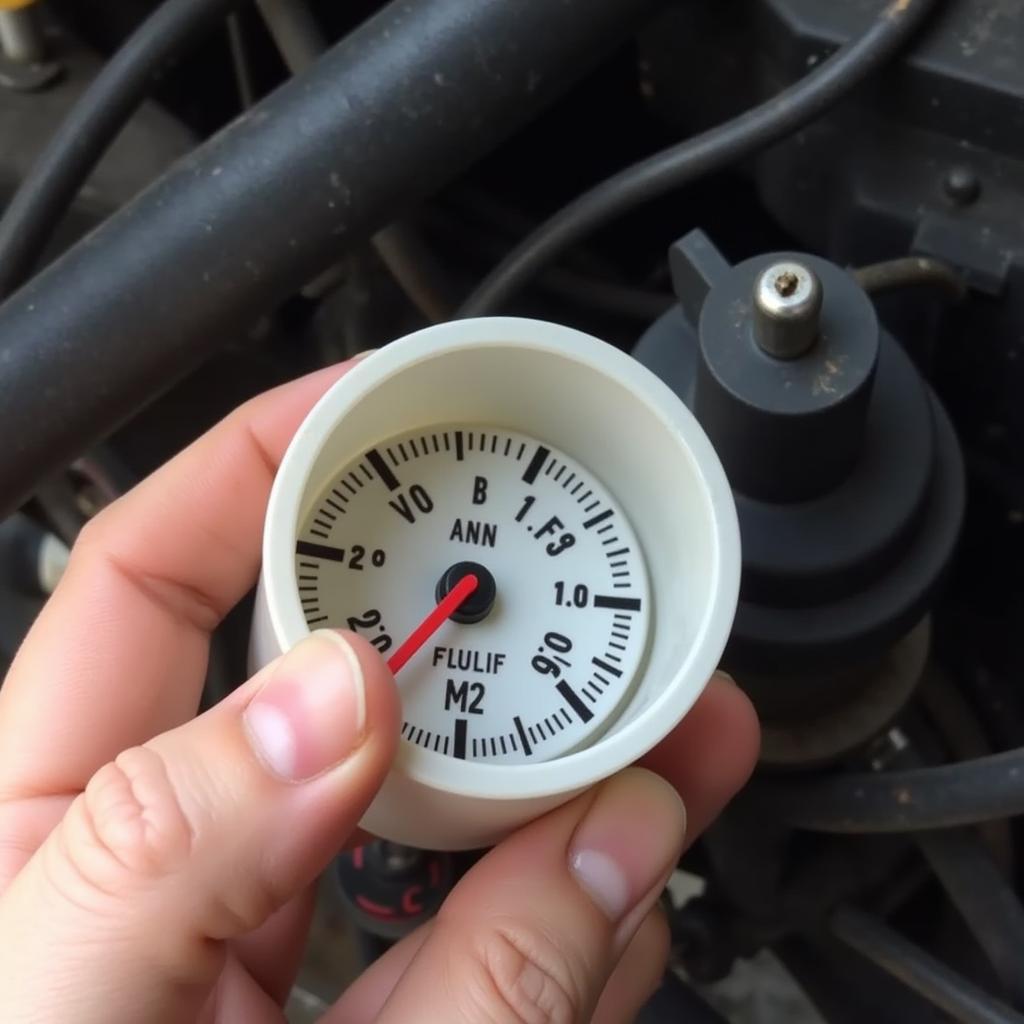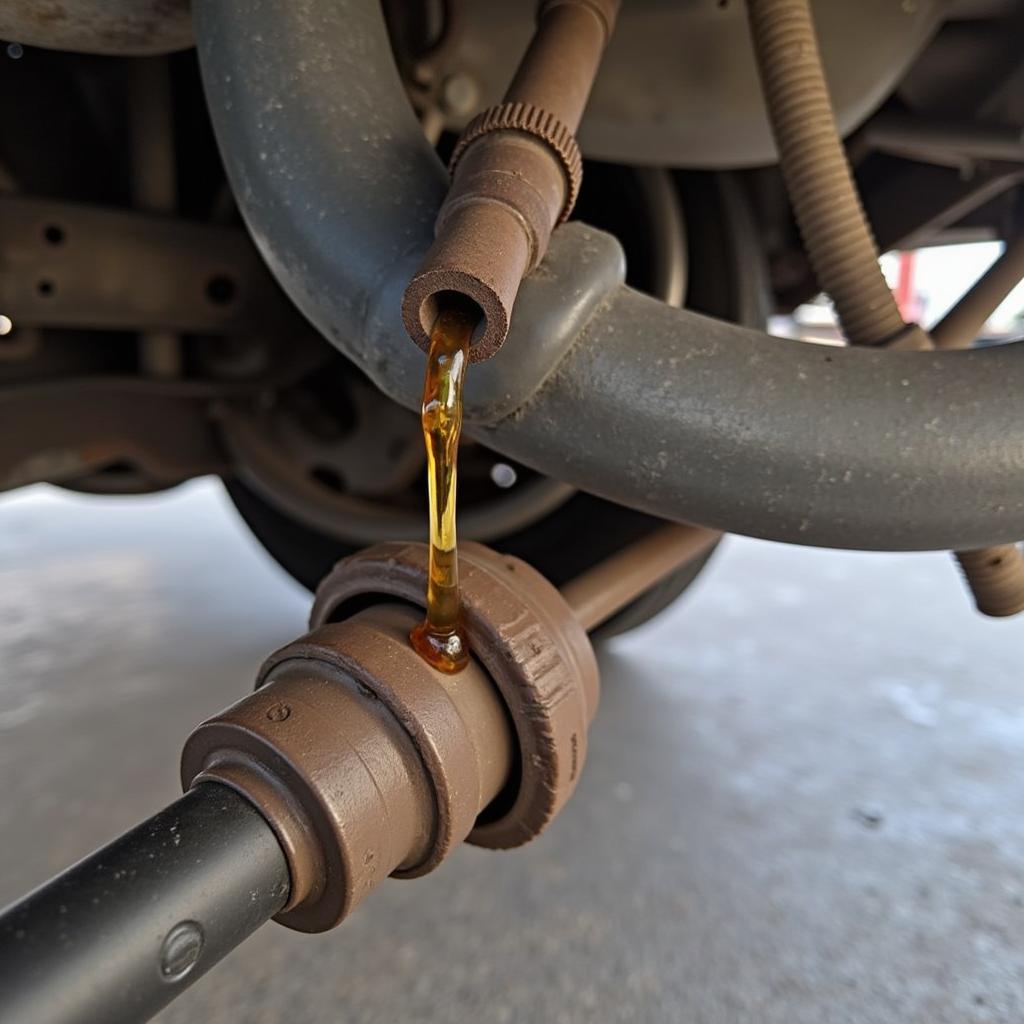The brake warning light on your 1997 Ford F150 dashboard is a crucial safety feature, illuminating when the system detects an issue. Ignoring this warning could lead to serious consequences, compromising your ability to stop safely. This comprehensive guide delves into common causes behind the 97 Ford F150 brake warning and offers potential solutions to help you regain control and ensure your safety on the road.
Understanding Your F150’s Brake Warning System
Before diving into troubleshooting, it’s essential to understand how your truck’s brake warning system functions. The system relies on several components working in harmony:
- Brake Fluid Level Sensor: Monitors the brake fluid level in the master cylinder, illuminating the warning light if it falls below a safe level.
- Parking Brake Switch: Activates the warning light when the parking brake is engaged, reminding you to disengage it before driving.
- Hydraulic System Pressure Differential: The system is designed to detect imbalances in hydraulic pressure between the front and rear brake circuits. A pressure difference could indicate a leak or other malfunction.
- ABS System: If your F150 is equipped with Anti-lock Brakes (ABS), a separate warning light might illuminate if the ABS module detects a fault within the system.
Common Causes of a 97 Ford F150 Brake Warning
1. Low Brake Fluid: The Most Common Culprit
Low brake fluid is often the primary suspect behind a brake warning light. Brake fluid is the lifeblood of your braking system, transmitting force to engage the brakes. Over time, brake pads wear down, requiring more fluid to achieve the same stopping power.
Solution: Check the brake fluid level in the master cylinder reservoir. If it’s low, adding brake fluid might temporarily extinguish the light. However, it’s crucial to determine the underlying cause of the low fluid level. Leaky brake lines, worn brake calipers, or failing wheel cylinders could be contributing to fluid loss. It’s recommended to have a professional mechanic inspect the entire system for leaks and worn components.
 Checking brake fluid level in a 1997 Ford F150
Checking brake fluid level in a 1997 Ford F150
2. Worn Brake Pads: Time for a Replacement
As brake pads wear down, the calipers need to extend further to clamp the rotors, consuming more brake fluid in the process. This can trigger the brake warning light, especially if the pads are significantly worn.
Solution: Inspect your brake pads for wear. If they appear thin or you hear a grinding noise when applying the brakes, it’s time for a replacement. Consider replacing all four brake pads simultaneously to maintain balanced braking performance.
3. Brake System Leaks: A Serious Concern
Leaks within the brake system can lead to a dangerous loss of brake fluid and hydraulic pressure. This compromises your ability to stop effectively and safely. Common leak points include brake lines, hoses, calipers, and wheel cylinders.
Solution: Carefully inspect all brake components for signs of leaks, such as wetness, drips, or corrosion. If you suspect a leak, it’s crucial to address it immediately. Repairing or replacing leaking components requires specialized tools and knowledge, making it advisable to consult a qualified mechanic.
 Inspecting for brake system leaks on a 1997 Ford F150
Inspecting for brake system leaks on a 1997 Ford F150
4. Faulty Brake Warning Light Switch: A False Alarm?
While less common, a malfunctioning brake warning light switch can trigger the warning light even if there’s no actual problem with the braking system. The switch is typically located near the brake pedal and can wear out or fail over time.
Solution: To test the switch, try jiggling the brake pedal while observing the warning light. If the light flickers or turns off momentarily, the switch might be faulty and require replacement.
5. ABS Issues: When Your Anti-lock Brakes Act Up
If your 1997 Ford F150 is equipped with ABS, a separate warning light might illuminate on the dashboard if the ABS module detects a fault. This could indicate a problem with the ABS wheel speed sensors, the ABS control module, or the wiring within the system.
Solution: Diagnosing ABS issues requires specialized diagnostic equipment. If you suspect a problem with your ABS system, it’s recommended to have your vehicle inspected by a qualified mechanic specializing in ABS repairs.
Remote Diagnostic and Programming Services: Modern Solutions for Your F150
In today’s technologically advanced world, remote diagnostic and programming services offer a convenient and efficient way to diagnose and resolve certain vehicle issues, including some brake-related concerns. By connecting to your vehicle remotely, specialized technicians can:
- Retrieve Diagnostic Trouble Codes (DTCs): Accessing stored DTCs provides valuable insights into the root cause of the brake warning light.
- Analyze Live Data Streams: Monitoring real-time sensor data allows technicians to assess system performance and identify potential malfunctions.
- Perform Software Updates: In some cases, outdated software within the ABS module or other electronic control units (ECUs) could contribute to brake warning light issues. Remote programming allows technicians to install the latest software updates, potentially resolving the problem.
79 ford f150 brake warning light switch wiring diagram
When to Seek Professional Help
While some brake warning light issues can be addressed with basic troubleshooting, certain situations warrant the expertise of a qualified mechanic. These include:
- Suspected brake fluid leaks: Addressing leaks requires specialized tools and knowledge to ensure a safe and reliable repair.
- Worn or damaged brake components: Replacing calipers, rotors, or other brake parts is best left to professionals with the proper equipment and experience.
- ABS system faults: Diagnosing and repairing ABS issues often requires specialized diagnostic tools and in-depth knowledge of these complex systems.
- Electrical problems: Issues with wiring, sensors, or the brake warning light switch are best handled by experienced mechanics equipped to diagnose and repair electrical systems.
1997 f150 brake warning resistor diode assembly
“Ignoring a brake warning light can be incredibly dangerous,” warns John Miller, a seasoned automotive technician with over 20 years of experience. “What might seem like a minor inconvenience could quickly escalate into a serious safety hazard. If you’re unsure about anything related to your brakes, it’s always best to err on the side of caution and consult a professional.”
Conclusion
The brake warning light on your 1997 Ford F150 is a critical safety indicator, demanding your immediate attention. Understanding the potential causes and solutions outlined in this guide can empower you to address the issue effectively or seek professional assistance when needed. Remember, a well-maintained brake system is essential for your safety and the safety of others on the road.
